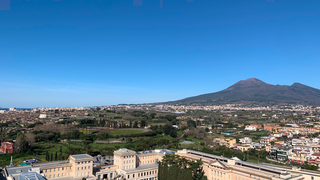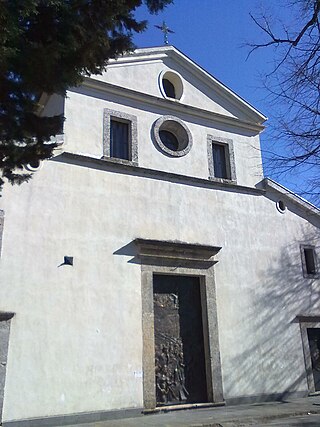
Pompei or Pompeii is a city and commune in the Metropolitan City of Naples, Italy, home of the ancient Roman ruins of Pompeii that are part of the UNESCO World Heritage Sites.

Campagna is a small town and comune of the province of Salerno, in the Campania region of Southern Italy. Its population is 17,148. Its old Latin name was Civitas Campaniae. Campagna is located in one of the valleys of the Picentini Mountains, at an altitude of 270 meters above sea level.

Esquilino is the 15th rione of Rome, identified by the initials R. XV, and is Located within the Municipio I. It is named after the Esquiline Hill, one of the Seven Hills of Rome.

There are more than 900 churches in Rome, which makes it the city with the largest number of churches in the world. Most, but not all, of these are Catholic.

Acerno is a town and comune in the province of Salerno in the region of Campania in south-western Italy.

Oliveto Citra is a town and comune in the province of Salerno in the Campania region of south-western Italy. It is located 55 kilometres (34 mi) by road northeast of Salerno. As of 2016, the comune had 3,802 inhabitants and covered an area of 31.62 square kilometres (12.21 sq mi).

Moncalvo is a village and comune in the Province of Asti in the Italian region Piedmont, located about 45 kilometres (28 mi) east of Turin and about 15 kilometres (9 mi) northeast of Asti on the national road SS 547 which links Asti to Casale Monferrato and Vercelli. Historically it was part of the state of Montferrat and was of particular importance during the early years of the Paleologi period of the marquisate. Its best-known inhabitants were the Baroque painter Guglielmo Caccia and ‘La Bella Rosin’, King Victor Emmanuel II’s favourite mistress and eventually wife.

The Archdiocese of Bologna is a Latin Church ecclesiastical territory or archdiocese of the Catholic Church in Northern Italy. The cathedra is in the cathedral church of San Pietro, Bologna. The current archbishop is Cardinal Matteo Zuppi, who was installed in 2015.

Bernardo Antonio Vittone was an Italian architect and writer. He was one of the three most important Baroque architects active in the Piedmont region of Northern Italy; the other two were Filippo Juvarra and Guarino Guarini. The youngest of the three, Vittone was the only one who was born in Piedmont. He achieved a synthesis of the spatial inventiveness of Juvarra and the engineering ingenuity of Guarini, particularly in the design of his churches, the buildings for which he is best known.

Pompeo Ghitti was an Italian painter of the Baroque period, active mainly in and in towns surrounding Brescia.

Charitable institutions attached to churches in Rome were founded right through the medieval period and included hospitals, hostels, and others providing assistance to pilgrims to Rome from a certain "nation", which thus became these nations' national churches in Rome. These institutions were generally organized as confraternities and funded through charity and legacies from rich benefactors belonging to that "nation". Often, they were also connected to national scholæ, where the clergymen of that nation were trained. The churches and their riches were a sign of the importance of their nation and of the prelates that supported them. Up to 1870 and Italian unification, these national churches also included churches of the Italian states.
The Diocese of Acerno was a Roman Catholic diocese based in Acerno, a distance of 68 km (42 mi.) from Naples in southern Italy, with the bishop's seat in Acerno Cathedral. Created in the 11th century, in 1818, the diocese was granted in perpetual administratorship to the archbishops of Salerno. In the reorganization of ecclesiastical provinces in 1986, Acerno was suppressed, to create the Archdiocese of Salerno-Campagna-Acerno.

Palermo, main city of Sicily, has a big heritage of churches which ranges from the Arab-Norman-Byzantine style to the Gothic and the Baroque styles. In particular, the list includes the most important churches of the historic centre divided by the four areas of Kalsa, Albergaria, Seralcadi and Loggia.
The Diocese of Satriano e Campagna was a Roman Catholic diocese located in the town of Satriano in the Province of Catanzaro in the Calabria region of southern Italy. In 1818, the diocese of Campagna was united with the Archdiocese of Conza to form the Archdiocese of Conza e Campagna. The diocese of Satriano was completely suppressed, and its territory incorporated into the diocese of Campagna.
















